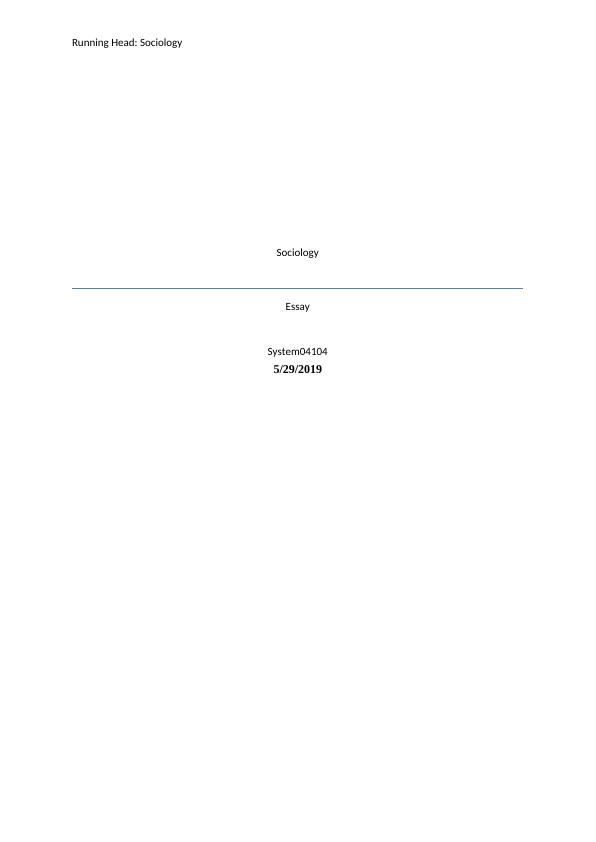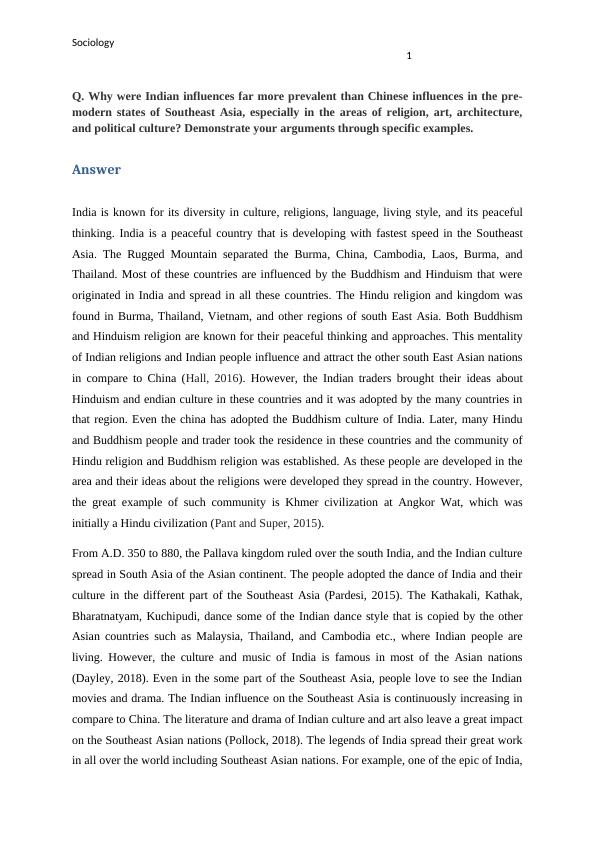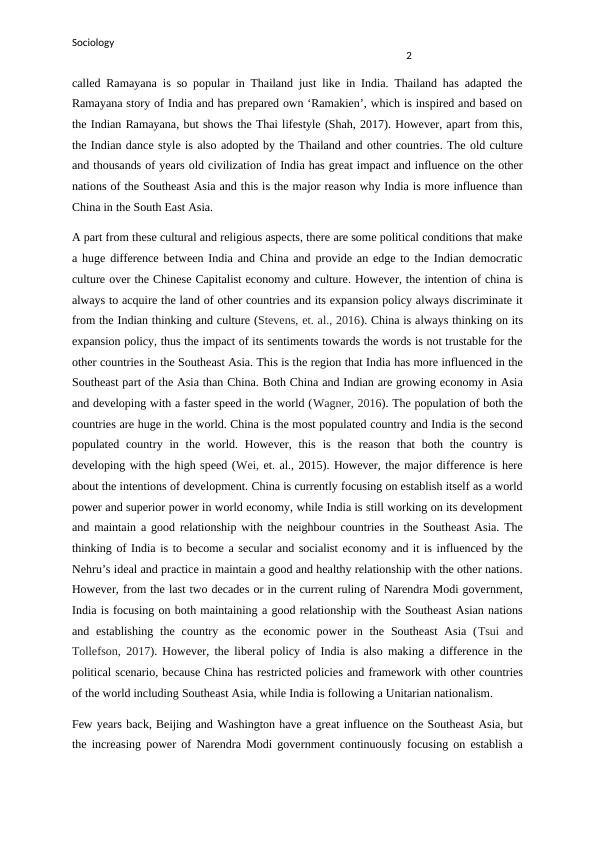Indian Influences in Southeast Asia
Added on 2023-03-30
6 Pages1407 Words194 Views
Running Head: Sociology
Sociology
Essay
System04104
5/29/2019
Sociology
Essay
System04104
5/29/2019

Sociology
1
Q. Why were Indian influences far more prevalent than Chinese influences in the pre-
modern states of Southeast Asia, especially in the areas of religion, art, architecture,
and political culture? Demonstrate your arguments through specific examples.
Answer
India is known for its diversity in culture, religions, language, living style, and its peaceful
thinking. India is a peaceful country that is developing with fastest speed in the Southeast
Asia. The Rugged Mountain separated the Burma, China, Cambodia, Laos, Burma, and
Thailand. Most of these countries are influenced by the Buddhism and Hinduism that were
originated in India and spread in all these countries. The Hindu religion and kingdom was
found in Burma, Thailand, Vietnam, and other regions of south East Asia. Both Buddhism
and Hinduism religion are known for their peaceful thinking and approaches. This mentality
of Indian religions and Indian people influence and attract the other south East Asian nations
in compare to China (Hall, 2016). However, the Indian traders brought their ideas about
Hinduism and endian culture in these countries and it was adopted by the many countries in
that region. Even the china has adopted the Buddhism culture of India. Later, many Hindu
and Buddhism people and trader took the residence in these countries and the community of
Hindu religion and Buddhism religion was established. As these people are developed in the
area and their ideas about the religions were developed they spread in the country. However,
the great example of such community is Khmer civilization at Angkor Wat, which was
initially a Hindu civilization (Pant and Super, 2015).
From A.D. 350 to 880, the Pallava kingdom ruled over the south India, and the Indian culture
spread in South Asia of the Asian continent. The people adopted the dance of India and their
culture in the different part of the Southeast Asia (Pardesi, 2015). The Kathakali, Kathak,
Bharatnatyam, Kuchipudi, dance some of the Indian dance style that is copied by the other
Asian countries such as Malaysia, Thailand, and Cambodia etc., where Indian people are
living. However, the culture and music of India is famous in most of the Asian nations
(Dayley, 2018). Even in the some part of the Southeast Asia, people love to see the Indian
movies and drama. The Indian influence on the Southeast Asia is continuously increasing in
compare to China. The literature and drama of Indian culture and art also leave a great impact
on the Southeast Asian nations (Pollock, 2018). The legends of India spread their great work
in all over the world including Southeast Asian nations. For example, one of the epic of India,
1
Q. Why were Indian influences far more prevalent than Chinese influences in the pre-
modern states of Southeast Asia, especially in the areas of religion, art, architecture,
and political culture? Demonstrate your arguments through specific examples.
Answer
India is known for its diversity in culture, religions, language, living style, and its peaceful
thinking. India is a peaceful country that is developing with fastest speed in the Southeast
Asia. The Rugged Mountain separated the Burma, China, Cambodia, Laos, Burma, and
Thailand. Most of these countries are influenced by the Buddhism and Hinduism that were
originated in India and spread in all these countries. The Hindu religion and kingdom was
found in Burma, Thailand, Vietnam, and other regions of south East Asia. Both Buddhism
and Hinduism religion are known for their peaceful thinking and approaches. This mentality
of Indian religions and Indian people influence and attract the other south East Asian nations
in compare to China (Hall, 2016). However, the Indian traders brought their ideas about
Hinduism and endian culture in these countries and it was adopted by the many countries in
that region. Even the china has adopted the Buddhism culture of India. Later, many Hindu
and Buddhism people and trader took the residence in these countries and the community of
Hindu religion and Buddhism religion was established. As these people are developed in the
area and their ideas about the religions were developed they spread in the country. However,
the great example of such community is Khmer civilization at Angkor Wat, which was
initially a Hindu civilization (Pant and Super, 2015).
From A.D. 350 to 880, the Pallava kingdom ruled over the south India, and the Indian culture
spread in South Asia of the Asian continent. The people adopted the dance of India and their
culture in the different part of the Southeast Asia (Pardesi, 2015). The Kathakali, Kathak,
Bharatnatyam, Kuchipudi, dance some of the Indian dance style that is copied by the other
Asian countries such as Malaysia, Thailand, and Cambodia etc., where Indian people are
living. However, the culture and music of India is famous in most of the Asian nations
(Dayley, 2018). Even in the some part of the Southeast Asia, people love to see the Indian
movies and drama. The Indian influence on the Southeast Asia is continuously increasing in
compare to China. The literature and drama of Indian culture and art also leave a great impact
on the Southeast Asian nations (Pollock, 2018). The legends of India spread their great work
in all over the world including Southeast Asian nations. For example, one of the epic of India,

Sociology
2
called Ramayana is so popular in Thailand just like in India. Thailand has adapted the
Ramayana story of India and has prepared own ‘Ramakien’, which is inspired and based on
the Indian Ramayana, but shows the Thai lifestyle (Shah, 2017). However, apart from this,
the Indian dance style is also adopted by the Thailand and other countries. The old culture
and thousands of years old civilization of India has great impact and influence on the other
nations of the Southeast Asia and this is the major reason why India is more influence than
China in the South East Asia.
A part from these cultural and religious aspects, there are some political conditions that make
a huge difference between India and China and provide an edge to the Indian democratic
culture over the Chinese Capitalist economy and culture. However, the intention of china is
always to acquire the land of other countries and its expansion policy always discriminate it
from the Indian thinking and culture (Stevens, et. al., 2016). China is always thinking on its
expansion policy, thus the impact of its sentiments towards the words is not trustable for the
other countries in the Southeast Asia. This is the region that India has more influenced in the
Southeast part of the Asia than China. Both China and Indian are growing economy in Asia
and developing with a faster speed in the world (Wagner, 2016). The population of both the
countries are huge in the world. China is the most populated country and India is the second
populated country in the world. However, this is the reason that both the country is
developing with the high speed (Wei, et. al., 2015). However, the major difference is here
about the intentions of development. China is currently focusing on establish itself as a world
power and superior power in world economy, while India is still working on its development
and maintain a good relationship with the neighbour countries in the Southeast Asia. The
thinking of India is to become a secular and socialist economy and it is influenced by the
Nehru’s ideal and practice in maintain a good and healthy relationship with the other nations.
However, from the last two decades or in the current ruling of Narendra Modi government,
India is focusing on both maintaining a good relationship with the Southeast Asian nations
and establishing the country as the economic power in the Southeast Asia (Tsui and
Tollefson, 2017). However, the liberal policy of India is also making a difference in the
political scenario, because China has restricted policies and framework with other countries
of the world including Southeast Asia, while India is following a Unitarian nationalism.
Few years back, Beijing and Washington have a great influence on the Southeast Asia, but
the increasing power of Narendra Modi government continuously focusing on establish a
2
called Ramayana is so popular in Thailand just like in India. Thailand has adapted the
Ramayana story of India and has prepared own ‘Ramakien’, which is inspired and based on
the Indian Ramayana, but shows the Thai lifestyle (Shah, 2017). However, apart from this,
the Indian dance style is also adopted by the Thailand and other countries. The old culture
and thousands of years old civilization of India has great impact and influence on the other
nations of the Southeast Asia and this is the major reason why India is more influence than
China in the South East Asia.
A part from these cultural and religious aspects, there are some political conditions that make
a huge difference between India and China and provide an edge to the Indian democratic
culture over the Chinese Capitalist economy and culture. However, the intention of china is
always to acquire the land of other countries and its expansion policy always discriminate it
from the Indian thinking and culture (Stevens, et. al., 2016). China is always thinking on its
expansion policy, thus the impact of its sentiments towards the words is not trustable for the
other countries in the Southeast Asia. This is the region that India has more influenced in the
Southeast part of the Asia than China. Both China and Indian are growing economy in Asia
and developing with a faster speed in the world (Wagner, 2016). The population of both the
countries are huge in the world. China is the most populated country and India is the second
populated country in the world. However, this is the reason that both the country is
developing with the high speed (Wei, et. al., 2015). However, the major difference is here
about the intentions of development. China is currently focusing on establish itself as a world
power and superior power in world economy, while India is still working on its development
and maintain a good relationship with the neighbour countries in the Southeast Asia. The
thinking of India is to become a secular and socialist economy and it is influenced by the
Nehru’s ideal and practice in maintain a good and healthy relationship with the other nations.
However, from the last two decades or in the current ruling of Narendra Modi government,
India is focusing on both maintaining a good relationship with the Southeast Asian nations
and establishing the country as the economic power in the Southeast Asia (Tsui and
Tollefson, 2017). However, the liberal policy of India is also making a difference in the
political scenario, because China has restricted policies and framework with other countries
of the world including Southeast Asia, while India is following a Unitarian nationalism.
Few years back, Beijing and Washington have a great influence on the Southeast Asia, but
the increasing power of Narendra Modi government continuously focusing on establish a

End of preview
Want to access all the pages? Upload your documents or become a member.
Related Documents
Intangible Cultural Heritage (PDF)lg...
|9
|1880
|87
India | History, Map, Population, Economy, & Factslg...
|8
|2793
|21
Analysing the Cultural, Social, and Physical Features of Tourist Destinationslg...
|15
|1260
|252
Characterizing Historical Approach to Understand Contemporary Southeast Asialg...
|4
|542
|395
Myanmar Crisis: A Brief Overview of the Country's History and the Rohingya Refugee Crisislg...
|5
|1148
|354
political regime evolution of Myanmar Assignment pdflg...
|12
|2954
|32
